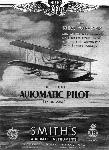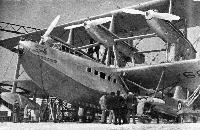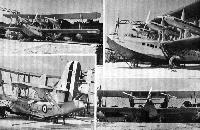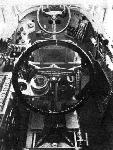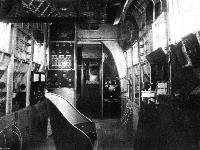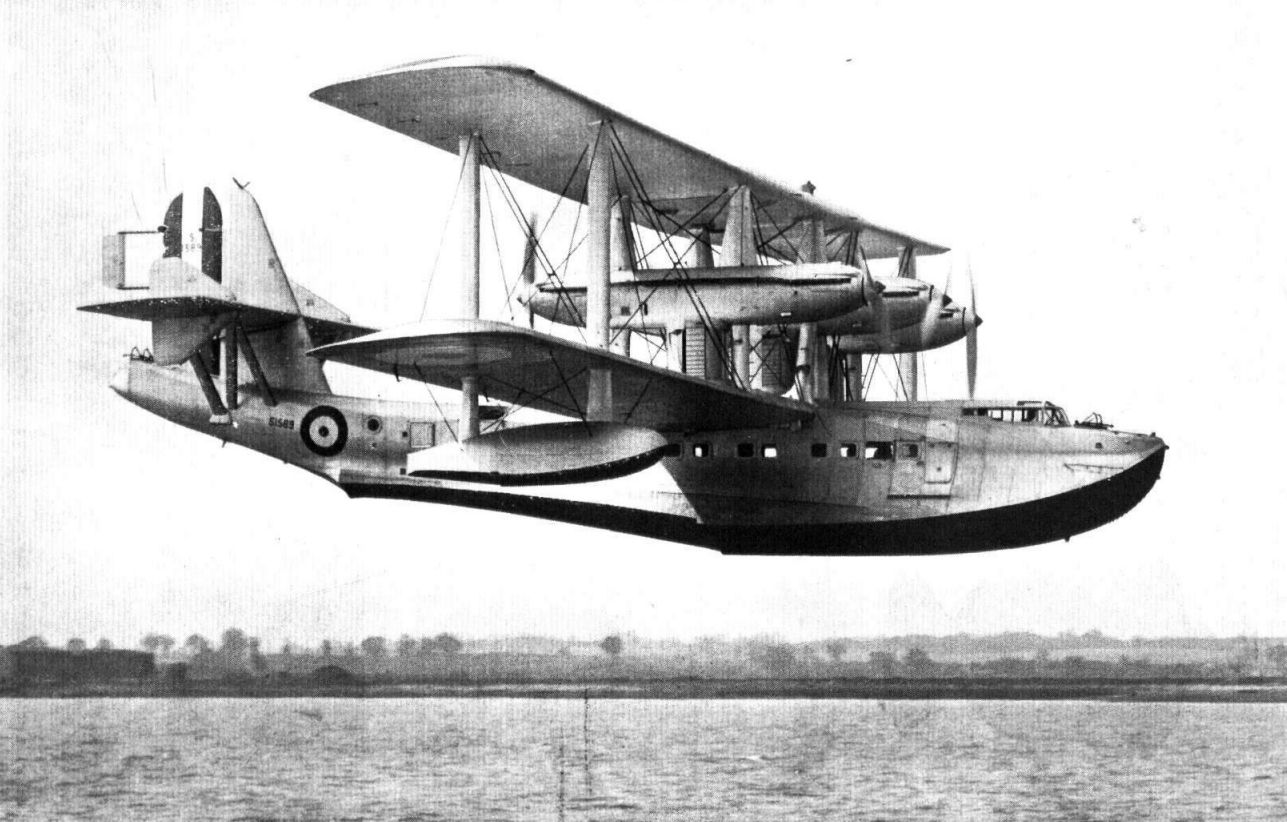
Варианты
Short. Различные самолеты 1920-1932 годов
<...>
Несколько большим по размерам был S.14 Sarafand, совершивший первый полет 30 июня 1932 года. Это был чисто экспериментальный самолет, который утилизировали в 1936 году.
<...>
Описание:
- Short. Различные самолеты 1920-1932 годов
- Flight, July 1932
THE SHORT R.6/28 FLYING BOAT "PRESENTED" - Flight, November 1932
British Aircraft - Flight, June 1935
THE SHORT "SARAFAND"
Фотографии
-
Flight 1932-07 / Flight
Регистрационный номер: S1589 [32] THE NEW 6-ENGINED SHORT FLYING BOAT (ROLLS-ROYCE "BUZZARDS"): Although launched only a fortnight ago, the boat could be demonstrated with every confidence on Monday last. It was flown by Mr. Lankester Parker. Like other Short flying boats, the new machine was "right" from the very start, and needed practically no modifications at all.
-
Air-Britain Aeromilitaria 1983-03
Регистрационный номер: S1589 [32] S1589 in full flight after modifications. Some additional footholds have appeared below the cockpit
-
Air Enthusiast 1992-12 / P.MacDougall - Medway Dynasty
Регистрационный номер: S1589 [32] Sarafand S1589, built to its ‘own’ specification (R6/28) and powered by six Rolls-Royce Buzzards. It first flew on June 30, 1931 and was scrapped in 1936.
-
Aeroplane Monthly 1993-04 / C.Prower - From Brisfit to Beverley (1)
Регистрационный номер: S1589 [32] Short Sarafand S1589, the sole example, was first flown on June 30, 1932. The 120ft span ’boat was scrapped at Felixstowe in 1936, on of its last public appearances being at the 1935 RAF display at Hendon.
-
Flight 1933-08 / Flight Advertisements
Регистрационный номер: S1589 [32] -
Flight 1936-01 / Flight Advertisements
Регистрационный номер: S1589 [32] Sarafand создавался как разведывательная и патрульная летающая лодка большой дальности. Первый полет состоялся 30 июня 1932 года. Самолет имел бипланную коробку размахом 36,58 м и оснащался шестью двигателями Rolls-Royce Buzzard, установленными попарно тандемом.
The R6/28. 6 Rolls-Royce 'Buzzard' Engines designed & Built by SHORT BROS LTD. ROCHESTER -
Flight 1936-06 / Flight Advertisements
Регистрационный номер: S1589 [32] -
Air-Britain Aeromilitaria 1983-03
Регистрационный номер: S1589 [32] The Sarafand in her original state soon after launching
-
Flight 1932-08 / Flight
Регистрационный номер: S1589 [32] AN "EEL'S EYE" VIEW: The six-engined Short Military Flying Boat (Rolls-Royce "Buzzards") flying overhead, piloted by Mr. Lankester Parker. This photograph gives a very good idea of the shape of the underwater portion of the hull.
-
Aeroplane Monthly 1985-06 / ??? - RAF Pageantry
Регистрационный номер: S1589 [32] The flying boats: In the vee, left to right, are the Vickers-Supermarine "Scapa" and "Stranraer," Short "Sarafand" and "Singapore III," and Saro "London"; bringing up the rear is the Saro "Cloud" (Short "Knuckleduster" ???)
Like fish out of water - six flying-boats from Felixstowe. They are, from left to right, Scapa, Stranraer, Sarafand, Singapore, London and, in the rear, the Cloud.Другие самолёты на фотографии: Saunders-Roe London / A.27 - Великобритания - 1934Short Knuckleduster / S.18 - Великобритания - 1933Short Singapore III / S.19 - Великобритания - 1934Supermarine Scapa - Великобритания - 1932Supermarine Stranraer - Великобритания - 1934
-
Flight 1935-02 / Flight Advertisements
Регистрационный номер: S1589 [32] THE LARGEST FLYING-BOAT EVER CONSTRUCTED IN ENGLAND 6 ROLLS-ROYCE ENGINES
-
Flight 1932-07 / Flight
Регистрационный номер: S1589 [32] -
Flight 1935-01 / Flight Advertisements
Регистрационный номер: S1589 [32] SHORT-ROLlS-ROYCE GIANT FLYING BOAT FITTED WITH 6 ROLLS-ROYCE BUZZARD' ENGINES WEIGHT 35 TONS
-
Air-Britain Aeromilitaria 1983-03
Регистрационный номер: S1589 [32] The Sarafand taxying on the River Medway at Rochester
-
Flight 1933-08 / Flight Advertisements
Регистрационный номер: S1589 [32] -
Flight 1935-06 / Flight
Регистрационный номер: S1589 [32] The mighty "Sarafand" or R.6/28 (six 825 h.p. "Buzzards")
-
Aeroplane Monthly 1979-02
Регистрационный номер: S1589 [32] Short Sarafand S1589, which first flew at Rochester on June 30, 1931.
-
Flight 1939-04 / Flight
Регистрационный номер: S1589 [32] The R.6/28 was second in size only to the German Do.X. Its Service name was Sarafand, and it had six Rolls-Royce Buzzard engines.
-
Flight 1932-07 / Flight
Регистрационный номер: S1589 [32] IN HER HOME WATERS: The Short six-engined flying boat ("Buzzards") at Moorings on the Medway. The official designation of this boat is "Flying Boat R.6/28."
-
Flight 1933-10 / Flight
Регистрационный номер: S1589 [32] A SHORT VISIT TO SCOTLAND: The Short six-engined flying-boat which paid a visit to Kirkwall Bay on September 21.
-
Flight 1933-08 / Flight Advertisements
Регистрационный номер: S1589 [32] The biggest flying boat ever built in Great Britain.
-
Air-Britain Aeromilitaria 1980-04
Регистрационный номер: S1589 [32] Short Sarafand S1589 on the ramp at Felixstowe in 1932
-
Flight 1932-07 / Flight
Регистрационный номер: S1589 [32] THE LATEST OPEN SEA RECONNAISSANCE MULTI-SEATER FLYING-BOAT: This new six-engined Short machine has just been launched at the Rochester works of Short Brothers. The engines are Rolls-Royce "Buzzards."
-
Air-Britain Aeromilitaria 1983-03
Регистрационный номер: S1589 [32] The massive central section of the Sarafand showing the original cooling system and freight access hatch
-
Air-Britain Aeromilitaria 1983-03
Регистрационный номер: S1589 [32] The tail section showing the tail gun position and the servo-rudder
-
Flight 1935-06 / Flight
One of the jacks used for lifting the flying boat off the ground when it is ashore. The ends of the beam are placed under points on the lower wing roots.
-
Flight 1935-06 / Flight
Регистрационный номер: S1589 [32] Although dual controls are provided, the pilots are arranged in tandem to give the first pilot the best possible view.
-
Flight 1935-06 / Flight
Регистрационный номер: S1589 [32] A view looking forward. The compartment in the foreground has a workbench with vice, etc., and a hatch through which can be lowered a spare engine.
-
Flight 1935-06 / Flight
Регистрационный номер: S1589 [32] The picture affords a peep into the W/T compartment.
-
Flight 1935-06 / Flight
Регистрационный номер: S1589 [32] The exchange: In this compartment are the switchboard for the electricity supply, telephones, etc., and the engine instruments under the care of the engineer.
-
Flight 1935-06 / Flight
Регистрационный номер: S1589 [32] The aft stowage space, and lavatory equipment. A gangway leads to the gun position in the extreme stern of the hull.
- Фотографии






